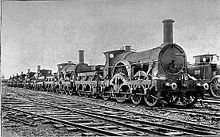| Revision as of 12:31, 1 August 2009 editJeepday (talk | contribs)Administrators28,700 edits Misplaced Pages:CiterSquad; you can help!← Previous edit | Revision as of 11:22, 27 December 2009 edit undoSmackBot (talk | contribs)3,734,324 editsm →Examples from the UK: Delink dates (WP:MOSUNLINKDATES) using Project:AWBNext edit → | ||
| Line 13: | Line 13: | ||
| == Examples from the UK == | == Examples from the UK == | ||
| * The ] class of ], built by ]. This ] express locomotives were first built in 1847 and had an 8 ft diameter ] size. | * The ] class of ], built by ]. This ] express locomotives were first built in 1847 and had an 8 ft diameter ] size. | ||
| * The later examples of the ] by ], 1893-1899, built for standard gauge. No 3065 ''Duke of Connaught'' made a record-breaking run with the '']'' express train on |
* The later examples of the ] by ], 1893-1899, built for standard gauge. No 3065 ''Duke of Connaught'' made a record-breaking run with the '']'' express train on 9 May 1904, covering the distance from Plymouth to Paddington in 227 minutes. | ||
| * The ] of the ], which ran an average speed of more than 60 mph during the ], built first in 1870. They were called ''eight-footer'' because of the big ], that was more than 8 ft. in diameter. | * The ] of the ], which ran an average speed of more than 60 mph during the ], built first in 1870. They were called ''eight-footer'' because of the big ], that was more than 8 ft. in diameter. | ||
| * The ]'s ] "Spinners". One, No. 673, survives at the ], York. | * The ]'s ] "Spinners". One, No. 673, survives at the ], York. | ||
Revision as of 11:22, 27 December 2009
| This article does not cite any sources. Please help improve this article by adding citations to reliable sources. Unsourced material may be challenged and removed. Find sources: "4-2-2" – news · newspapers · books · scholar · JSTOR (August 2009) (Learn how and when to remove this message) |

Under the Whyte notation for the classification of steam locomotives, a 4-2-2 locomotive has four leading wheels, two driving wheels and two trailing wheels.
Other equivalent classifications are:
UIC classification: 2A1 (also known as German classification and Italian classification)
French classification: 211
Turkish classification: 14
Swiss classification: 1/4
Like other steam locomotive types with single pairs of driving wheels, they were also known as singles.
Examples from the UK
- The Iron Duke class of Great Western Railway, built by Daniel Gooch. This broad gauge express locomotives were first built in 1847 and had an 8 ft diameter driving wheel size.
- The later examples of the GWR 3031 Class by William Dean, 1893-1899, built for standard gauge. No 3065 Duke of Connaught made a record-breaking run with the Ocean Mail express train on 9 May 1904, covering the distance from Plymouth to Paddington in 227 minutes.
- The GNR Stirling 4-2-2 of the Great Northern Railway, which ran an average speed of more than 60 mph during the race to the north, built first in 1870. They were called eight-footer because of the big driving wheel, that was more than 8 ft. in diameter.
- The Midland Railway's 115 class "Spinners". One, No. 673, survives at the National Railway Museum, York.
- A further notable UK class 4-2-2 is the GER Class P43, which was an early oil-burning engine, developed by the pioneer of oil-boilers, James Holden

Examples from Germany

| Steam locomotive wheel arrangements (Whyte notation) | |
|---|---|
| Single engine types |
|
| Divided drive and Duplex engine types | |
| Articulated locomotives Fairlie, Meyer and Garratt types | |
| Articulated locomotives Mallet types | |
| Articulated locomotives Triplex and other Multiplex types | |
| Articulated locomotives Engerth types | |
| Geared locomotives | |
This steam locomotive-related article is a stub. You can help Misplaced Pages by expanding it. |